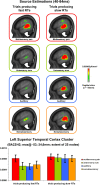Early, low-level auditory-somatosensory multisensory interactions impact reaction time speed
- PMID: 19404410
- PMCID: PMC2659167
- DOI: 10.3389/neuro.07.002.2009
Early, low-level auditory-somatosensory multisensory interactions impact reaction time speed
Abstract
Several lines of research have documented early-latency non-linear response interactions between audition and touch in humans and non-human primates. That these effects have been obtained under anesthesia, passive stimulation, as well as speeded reaction time tasks would suggest that some multisensory effects are not directly influencing behavioral outcome. We investigated whether the initial non-linear neural response interactions have a direct bearing on the speed of reaction times. Electrical neuroimaging analyses were applied to event-related potentials in response to auditory, somatosensory, or simultaneous auditory-somatosensory multisensory stimulation that were in turn averaged according to trials leading to fast and slow reaction times (using a median split of individual subject data for each experimental condition). Responses to multisensory stimulus pairs were contrasted with each unisensory response as well as summed responses from the constituent unisensory conditions. Behavioral analyses indicated that neural response interactions were only implicated in the case of trials producing fast reaction times, as evidenced by facilitation in excess of probability summation. In agreement, supra-additive non-linear neural response interactions between multisensory and the sum of the constituent unisensory stimuli were evident over the 40-84 ms post-stimulus period only when reaction times were fast, whereas subsequent effects (86-128 ms) were observed independently of reaction time speed. Distributed source estimations further revealed that these earlier effects followed from supra-additive modulation of activity within posterior superior temporal cortices. These results indicate the behavioral relevance of early multisensory phenomena.
Keywords: auditory; crossmodal; event-related potential; multisensory; reaction time; redundant signals effect; somatosensory; tactile.
Figures




Similar articles
-
Grabbing your ear: rapid auditory-somatosensory multisensory interactions in low-level sensory cortices are not constrained by stimulus alignment.Cereb Cortex. 2005 Jul;15(7):963-74. doi: 10.1093/cercor/bhh197. Epub 2004 Nov 10. Cereb Cortex. 2005. PMID: 15537674
-
Unisensory and Multisensory Responses in Fetal Alcohol Spectrum Disorders (FASD): Effects of Spatial Congruence.Neuroscience. 2020 Mar 15;430:34-46. doi: 10.1016/j.neuroscience.2020.01.013. Epub 2020 Jan 23. Neuroscience. 2020. PMID: 31982473 Free PMC article.
-
Auditory-somatosensory multisensory interactions in front and rear space.Neuropsychologia. 2007 Apr 9;45(8):1869-77. doi: 10.1016/j.neuropsychologia.2006.12.004. Epub 2007 Feb 7. Neuropsychologia. 2007. PMID: 17291546
-
The efficacy of single-trial multisensory memories.Multisens Res. 2013;26(5):483-502. doi: 10.1163/22134808-00002426. Multisens Res. 2013. PMID: 24649531 Review.
-
Integration of somatosensory and motor-related information in the auditory system.Front Neurosci. 2022 Oct 18;16:1010211. doi: 10.3389/fnins.2022.1010211. eCollection 2022. Front Neurosci. 2022. PMID: 36330342 Free PMC article. Review.
Cited by
-
Assessing the audiotactile Colavita effect in near and rear space.Exp Brain Res. 2010 Jun;203(3):517-32. doi: 10.1007/s00221-010-2255-x. Epub 2010 Apr 30. Exp Brain Res. 2010. PMID: 20431874
-
Early Sensory Loss Alters the Dendritic Branching and Spine Density of Supragranular Pyramidal Neurons in Rodent Primary Sensory Cortices.Front Neural Circuits. 2019 Sep 25;13:61. doi: 10.3389/fncir.2019.00061. eCollection 2019. Front Neural Circuits. 2019. PMID: 31611778 Free PMC article.
-
Multisensory interactions on auditory and somatosensory information in expert pianists.Sci Rep. 2022 Jul 22;12(1):12503. doi: 10.1038/s41598-022-16618-0. Sci Rep. 2022. PMID: 35869149 Free PMC article.
-
Multisensory Integration Enhances Temporal Coding in Ventral Cochlear Nucleus Bushy Cells.J Neurosci. 2018 Mar 14;38(11):2832-2843. doi: 10.1523/JNEUROSCI.2244-17.2018. Epub 2018 Feb 13. J Neurosci. 2018. PMID: 29440557 Free PMC article.
-
Perceptuo-motor compatibility governs multisensory integration in bimanual coordination dynamics.Exp Brain Res. 2016 Feb;234(2):463-74. doi: 10.1007/s00221-015-4476-5. Epub 2015 Nov 2. Exp Brain Res. 2016. PMID: 26525707
References
-
- American Electroencephalographic Society (1994). American Electroencephalographic Society. Guideline thirteen: guidelines for standard electrode position nomenclature. J. Clin. Neurophysiol. 11, 111–113 - PubMed
-
- Calvert G. A., Spence C., Stein B. E. (2004). The Handbook of Multisensory Processing. Cambridge, MA, MIT Press
Grants and funding
LinkOut - more resources
Full Text Sources

